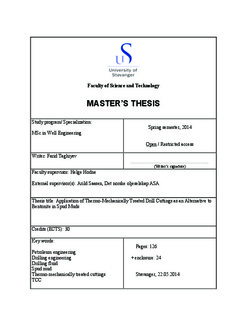| dc.contributor.author | Taghiyev, Farid | |
| dc.date.accessioned | 2014-09-22T13:30:10Z | |
| dc.date.available | 2014-09-22T13:30:10Z | |
| dc.date.issued | 2014-05-22 | |
| dc.identifier.uri | http://hdl.handle.net/11250/220965 | |
| dc.description | Master's thesis in Petroleum engineering | nb_NO |
| dc.description.abstract | Drill cuttings recovered after drilling with OBM today are treated and deposited at onshore facilities. The TWMA Company offers a new technology, which recovers drilled subsurface materials together with oil and water rests. Due to the similarity between subsurface rock mineralogy and conventional bentonite used in the drilling fluid industry an extended laboratory study was carried out to evaluate the possibility of spud mud development using thermo-mechanically treated drill cuttings.
Prior to the main experiment a study of the material itself was performed to obtain particle size distribution of treated drill cuttings. Four groups of experiments were performed and 28 different spud mud compositions were designed (two commonly known traditional fluids are included here). The experiments were divided in the following way: fresh water and cuttings; fresh water, cuttings and polymers; seawater, cuttings, polymers and other additives; aging experiments. CMC Hi-Vis, PAC and xanthan gum polymers were tested as stabilizing agents, while CMC Lo-Vis and barite were tested for filter loss control and weighting. The fluids were mixed using standard drilling fluid laboratory equipment and tested in accordance with the API 13B-1 practices.
It was revealed that this batch of treated drill cuttings could not provide the required viscosity profile and the mixtures had very low gel strengths varying from
0 to 2 lb/100 ft2. Moreover, hydration experiments demonstrated that the material was incapable of swelling even after long (10 days) exposure to fresh water. High chloride concentration (2400-4400 mg/l) and relatively low active clay content (21.4-35.6 kg/m3) in the prepared slurries were considered to be the main driving factors for this behavior. CMC Hi-Vis and PAC polymers provided unsatisfactory rheological improvements as low shear rate viscosity and gel strength remained very low. On the other hand, xanthan gum qualified as a robust stabilizing agent and stable spud mud compositions were designed. Effects of xanthan polymer concentration on the rheological properties of the fluids were studied and the obtained yield point calculated by Bingham model varied from 5.11 Pa to 12.8 Pa depending on the polymer concentration. Influence of cutting concentration on the plastic viscosity of stable spud mud compositions was studied with results varying from 6 cP to 12 cP. Effect of increased temperature on rheological properties was studied as well. CMC Lo-Vis demonstrated good filter loss control properties
(10 ml API) even at concentrations as low as 2.86 kg/m3. The designed drilling fluids were as well capable of suspending heavy barite particles, which are often required during installation of casing.
Even though the treated drill cuttings alone were not capable of yielding required fluid properties a stable spud mud was developed as the result of this laboratory study. The designed composition satisfies existing spud mud properties criteria and might be implemented in a large-scale test. | nb_NO |
| dc.language.iso | eng | nb_NO |
| dc.publisher | University of Stavanger, Norway | nb_NO |
| dc.relation.ispartofseries | Masteroppgave/UIS-TN-IPT/2014; | |
| dc.rights | Attribution 3.0 Norway | * |
| dc.rights.uri | http://creativecommons.org/licenses/by/3.0/no/ | * |
| dc.subject | petroleumsteknologi | nb_NO |
| dc.subject | boreteknologi | nb_NO |
| dc.subject | petroleum engineering | nb_NO |
| dc.subject | drilling engineering | nb_NO |
| dc.subject | drilling fluid | nb_NO |
| dc.subject | spud mud | nb_NO |
| dc.subject | thermo-mechanically treated cuttings | nb_NO |
| dc.subject | TCC | nb_NO |
| dc.title | Application of thermo-mechanically treated drill cuttings as an alternative to bentonite in spud muds | nb_NO |
| dc.type | Master thesis | nb_NO |
| dc.subject.nsi | VDP::Technology: 500::Rock and petroleum disciplines: 510::Petroleum engineering: 512 | nb_NO |

